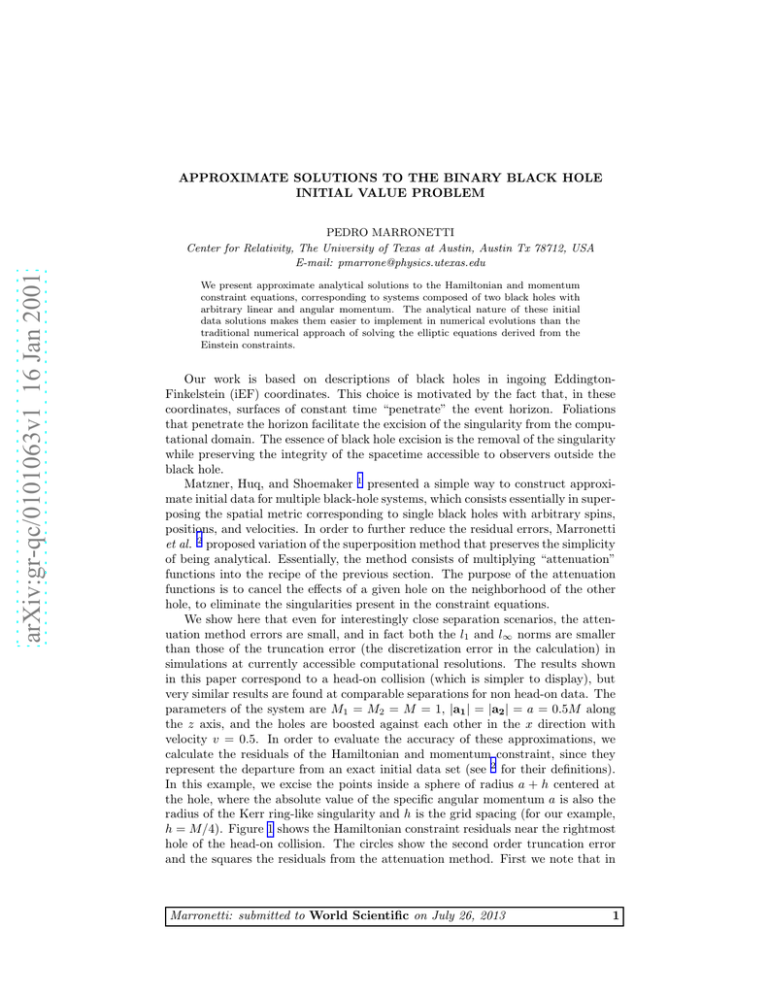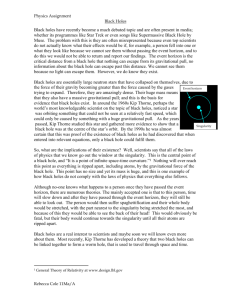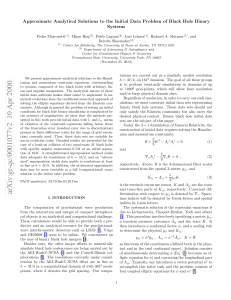Approximate Solutions to the Binary Black Hole Initial Value Problem
advertisement

APPROXIMATE SOLUTIONS TO THE BINARY BLACK HOLE INITIAL VALUE PROBLEM arXiv:gr-qc/0101063v1 16 Jan 2001 PEDRO MARRONETTI Center for Relativity, The University of Texas at Austin, Austin Tx 78712, USA E-mail: pmarrone@physics.utexas.edu We present approximate analytical solutions to the Hamiltonian and momentum constraint equations, corresponding to systems composed of two black holes with arbitrary linear and angular momentum. The analytical nature of these initial data solutions makes them easier to implement in numerical evolutions than the traditional numerical approach of solving the elliptic equations derived from the Einstein constraints. Our work is based on descriptions of black holes in ingoing EddingtonFinkelstein (iEF) coordinates. This choice is motivated by the fact that, in these coordinates, surfaces of constant time “penetrate” the event horizon. Foliations that penetrate the horizon facilitate the excision of the singularity from the computational domain. The essence of black hole excision is the removal of the singularity while preserving the integrity of the spacetime accessible to observers outside the black hole. Matzner, Huq, and Shoemaker 1 presented a simple way to construct approximate initial data for multiple black-hole systems, which consists essentially in superposing the spatial metric corresponding to single black holes with arbitrary spins, positions, and velocities. In order to further reduce the residual errors, Marronetti et al. 2 proposed variation of the superposition method that preserves the simplicity of being analytical. Essentially, the method consists of multiplying “attenuation” functions into the recipe of the previous section. The purpose of the attenuation functions is to cancel the effects of a given hole on the neighborhood of the other hole, to eliminate the singularities present in the constraint equations. We show here that even for interestingly close separation scenarios, the attenuation method errors are small, and in fact both the l1 and l∞ norms are smaller than those of the truncation error (the discretization error in the calculation) in simulations at currently accessible computational resolutions. The results shown in this paper correspond to a head-on collision (which is simpler to display), but very similar results are found at comparable separations for non head-on data. The parameters of the system are M1 = M2 = M = 1, |a1 | = |a2 | = a = 0.5M along the z axis, and the holes are boosted against each other in the x direction with velocity v = 0.5. In order to evaluate the accuracy of these approximations, we calculate the residuals of the Hamiltonian and momentum constraint, since they represent the departure from an exact initial data set (see 2 for their definitions). In this example, we excise the points inside a sphere of radius a + h centered at the hole, where the absolute value of the specific angular momentum a is also the radius of the Kerr ring-like singularity and h is the grid spacing (for our example, h = M/4). Figure 1 shows the Hamiltonian constraint residuals near the rightmost hole of the head-on collision. The circles show the second order truncation error and the squares the residuals from the attenuation method. First we note that in Marronetti: submitted to World Scientific on July 26, 2013 1 Hamiltonian Constr. x M 2 2.0 1.5 1.0 0.5 0.0 0 1 2 3 4 5 6 7 8 9 10 Figure 1. Hamiltonian constraint residuals near the rightmost hole of the head-on collision. some areas the violation of the constraints for the attenuated data is greater than that corresponding to truncation error. However, even in these areas the violation is smooth and small in absolute value, as opposed to the unbounded behavior shown by the truncation error near the singularity: the divergent behavior present at the singularity has disappeared with the use of attenuated data. This is due to the fact that, having cancelled the influence of the presence of the second hole, the metric and extrinsic curvature become the fields corresponding to an isolated black hole at the location of the singularity. This simplifies the exact problem, since this method provides exact inner boundary conditions for the elliptic solver. The applicability of these concepts to the numerical solution of the initial value problem has been confirmed by Marronetti and Matzner 3 , who presented the first results for a black-hole binary using the attenuation method to generate background data. These methods can be further refined to provide more astrophysically realistic initial data for the case of black holes in circular orbits, by deriving the extrinsic curvature Kij from the presence of a Killing vector ξ = ∂t + ω∂φ , instead of using the superposition of two boosted holes. Work under progress will incorporate these variations into the full numerical problem. References 1. R.A. Matzner, M.F. Huq, and D.Shoemaker, Phys. Rev. D 59, 024015 (1999). 2. P. Marronetti et al, Phys. Rev. D 62, 024017 (2000). 3. P. Marronetti and R.A. Matzner, gr-qc/0009044 , (2000). Marronetti: submitted to World Scientific on July 26, 2013 2





